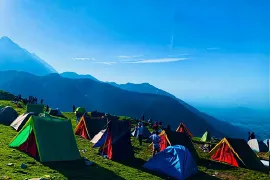Tikona Fort Trek: A Challenging Climb with Majestic Views
Tikona Fort, also known as Vitandgad, is a majestic hill fort situated amidst the Sahyadri Mountains near Lonavala, Maharashtra, India. This iconic landmark offers a challenging trek, rewarding hikers with breathtaking panoramic vistas, historical significance, and a unique natural setting.
Historical Significance:
- 16th Century Origins: Built in the 16th century by the Adilshahi dynasty, the fort played a crucial role in controlling the trade route between the Deccan plateau and the Konkan coast.
- Maratha Legacy: The Maratha Empire captured the fort in the 17th century, and it played a significant role in their fight for independence against the Mughals.
- Architectural Marvel: The fort showcases the architectural brilliance of the era, with remnants of fortification walls, bastions, cisterns, and secret passages, offering a glimpse into the fort's past.
Trekking Details:
- Difficulty: Difficult
- Distance: 5 kilometers (round trip)
- Duration: 4-5 hours
- Trail: Well-defined but steep and challenging, with some rock climbing sections
- Start Point: Patharwadi village
- Best Season: Winter (October to February)
What to Expect:
- Breathtaking Views: The challenging trek is rewarded with stunning panoramic vistas of the surrounding mountains, Lonavala town, and the picturesque Pawna Lake, making it a visually captivating experience.
- Unique Rock Formations: Encounter unique rock formations along the trail, adding to the natural beauty of the trek.
- Fort Exploration: Discover the remnants of the fort's structures, including fortification walls, water cisterns, and hidden chambers, offering a glimpse into its history and strategic significance. Explore the remnants of fortification walls, water cisterns, and hidden chambers, if accessible.
- Temple Visit: Visit the Hanuman temple located at the fort's summit, a popular spot for religious offerings and blessings.
Tips:
- Start your trek very early in the morning to avoid the harsh afternoon sun, especially during the summer months. Be prepared to spend at least 4-5 hours on the trek.
- Pack adequate water (at least 3 liters), snacks, and food, comfortable shoes with excellent grip (essential for the steep and rocky terrain), sunscreen, a hat, insect repellent, and gloves for better grip while climbing.
- Hiring a certified guide is highly recommended, especially for first-timers, as the trail can be challenging and requires a certain level of fitness. The guide can assist with navigation, provide insights into the fort's history, and ensure safety throughout the trek.
- Be aware of your surroundings, especially on uneven or steep sections of the trail, and follow safety precautions. Always prioritize your safety and turn back if you feel uncomfortable or exhausted.
Additional Points of Interest:
- Pawna Lake: A picturesque lake nestled amidst the mountains, offering boating and water sports activities.
- Visapur Fort: Another historic fort in the vicinity, known for its moderately challenging trek and scenic views.
- Karla Caves: Ancient Buddhist cave complex located nearby, showcasing intricate carvings and sculptures.
Conclusion:
The Tikona Fort Trek is an exceptional adventure for seasoned trekkers and history enthusiasts seeking a challenging climb, breathtaking natural beauty, and a touch of historical exploration. Remember, while the rewarding views and historical significance are alluring, it's crucial to prioritize your safety by being prepared, aware, and responsible throughout the trek.
Important Note:
- The information provided here is for general guidance only. It is important to do your own research and planning before attempting any trek.
- Always prioritize safety and follow the instructions of your guide or group leader.
- Be respectful of the environment and leave no trace behind.
